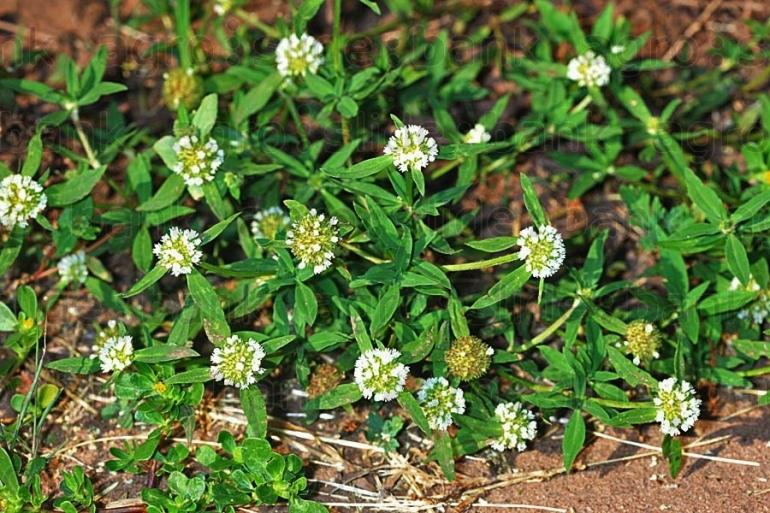Borreria verticillata.

|
|
Borreria verticillata Common Names: African Borreria, Shrubby False
Buttonweed, Whiteweed Scientific
Classification Kingdom: Plantae Phylum: Tracheophyta Class: Magnoliopsida Order: Gentianales Family: Rubiaceae Genus: Borreria Species: B. verticillata Synonyms: Bigelovia verticillata (L.) Spreng., Borreria commutata Spreng., Borreria globularioides Cham. & Schltdl., Borreria graminifolia M.Martens & Galeotti, Borreria kohautiana Cham. & Schltdl., Borreria laevigata M.Martens & Galeotti, Borreria minima DC., Borreria molleri Gand., Borreria oaxacana M.Martens & Galeotti, Borreria oligodonta Steyerm., Borreria podocephala DC., Borreria stricta G.Mey., Borreria thymocephala Griseb., Spermacoce fruticosa Pohl ex DC., Spermacoce globosa Schumach. & Thonn., Spermacoce hyssopifolia Pers., Spermacoce laeta Salisb., Spermacoce minima Pohl ex DC., Spermacoce mucronata Nees, Spermacoce polycephala Bartl. ex DC., Spermacoce pygmaea C.Wright, Spermacoce reclinata Nees, Spermacoce stellata Willd., Tardavel verticillata (L.) Hiern, Borreria verticillata Morphological Description Borreria verticillata, commonly known as African Borreria or Shrubby False Buttonweed,
is a small, erect, branched herbaceous perennial, typically growing 20–60 cm
tall, occasionally reaching 1 m. Its key features include: · Stem: Quadrangular, glabrous to slightly pubescent, often reddish
at the base · Leaves: Opposite, lanceolate to oblong, 1–5 cm long, 0.5–2 cm wide,
with short petioles, smooth to slightly hairy · Flowers: Small, white to pale pink, 2–4 mm long, in dense, spherical,
terminal or axillary clusters (1–2 cm in diameter) · Fruit: Capsule, 2–3 mm long, containing tiny, dark brown seeds The plant’s weedy
nature, antimicrobial properties, and traditional medicinal uses make it significant
in tropical ecosystems and ethnomedicine. Distribution and Habitat Borreria verticillata is native to tropical and subtropical regions of the
Americas, Africa, and Asia, with a wide distribution from South America
(Brazil, Venezuela) to West Africa (Nigeria, Senegal), East Africa (Kenya,
Tanzania), and parts of Asia (India, Indonesia). It has naturalized in
Australia and the Pacific Islands. It thrives in: · Ecosystems: Grasslands, open woodlands, savannas, disturbed areas,
roadsides, and agricultural fields · Climate: Tropical to subtropical, with rainfall of 500–2,000 mm
annually and temperatures of 20–35°C · Soils: Well-drained, sandy to loamy, tolerating poor, acidic soils · Altitude: Sea level to 1,500 m In Nigeria, it is common
in southern states like Ogun and northern savannas, often as a weed in fallow
lands and cultivated fields. Ethnopharmacology Borreria verticillata, also known as buttonweed or whitehead broom, is a medicinal
plant widely used in traditional medicine, especially in tropical and subtropical
regions. The leaves, stems, and roots are employed for their antimicrobial,
anti-inflammatory, antioxidant, antimalarial, and wound-healing properties.
Traditionally, it is used to treat skin infections, fevers, gastrointestinal
disorders like diarrhea and dysentery, as well as malaria and respiratory
infections. Poultices made from crushed leaves are often applied to wounds,
boils, and sores to promote healing. Phytochemical studies have revealed the
presence of alkaloids, flavonoids, tannins, and terpenoids, which are believed
to contribute to its therapeutic effects. Although Borreria verticillata shows
promise in traditional medicine, more scientific research is needed to fully
validate its pharmacological properties and ensure safe usage. · Antimicrobial Activity: Methanol root extracts inhibited multiresistant Pseudomonas aeruginosa (MIC
<50 µg/mL), validating their use for leucorrhea and blennorrhea in Brazil.
Leaf extracts were effective against Staphylococcus aureus (MIC 62.5 µg/mL) and Candida albicans (MIC 250 µg/mL), supporting treatment of skin
infections, eczema, and dermatitis in Nigeria and Ghana (Neto et al., 2002;
Aremu et al., 2016;). · Antimalarial Activity: Leaf
extracts reduced Plasmodium
berghei parasitemia in mice,
supporting their use for malaria in Senegal and Nigeria. Sesquiterpenes like
α-pinene enhance antimalarial effects (Balde et al., 2015;). · Antinociceptive Activity: Hydroalcoholic
extracts and ethyl acetate fractions of Borreria verticillata demonstrated
significant antinociceptive effects in animal models, including paw edema,
writhing, formalin, and tail flick tests. The activity is attributed to
compounds such as gallic acid, caffeic acid, ellagic acid, and ursolic acid,
which interact with COX-2 enzymes and NMDA receptors (Silva et al., 2017). · Antimicrobial Activity: Magic mushrooms for sale
online: Extracts from the leaves and roots exhibited antimicrobial properties
against various pathogens, including Staphylococcus aureus, Bacillus subtilis,
Klebsiella pneumoniae, Pseudomonas aeruginosa, Escherichia coli, Salmonella
typhi, and fungi like Trichophyton mentagrophytes and Candida albicans. The
antimicrobial action is closely related to the presence of alkaloids (Aremu et
al., 2016; Balde et al., 2015). ⚠ Toxicity Profile: Toxicological
evaluations have indicated that B. verticillata extracts are generally safe. In
acute toxicity studies, no mortality or significant toxic reactions were
observed in experimental animals at doses up to 2000 mg/kg body weight.
However, caution is advised, especially regarding long-term or high-dose use (Silva
et al., 2017).. Additional Uses · Agricultural Significance: The plant’s antimicrobial and
antinematodal properties make it a potential bionematicide against root-knot
nematodes (Meloidogyne incognita), reducing crop losses in Nigeria and Brazil. · Fodder: Aerial parts are used as fodder for livestock in Ghana,
providing moderate nutritional value · Ecological Role: As a pioneer species, it stabilizes
disturbed soils and enhances fertility in fallow fields in Nigeria. References
External Links More Pictures |
|
| Compounds of Borreria verticillata. | |
| References |